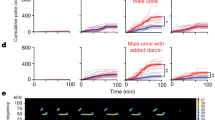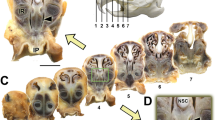Abstract
THE dominant part played by olfaction in the behaviour of lower mammals has long been appreciated, but it is only comparatively recently that the underlying physiological mechanisms have begun to be elucidated. There is now a considerable body of evidence implicating certain of the accepted olfactory projection sites, such as the amygdala and the pyriform cortex in emotional and reproductive behaviour1,2, and more recent work has shown how directly the more peripheral parts of the olfactory pathway may regulate reproductive function3,4. It has generally been assumed that the anatomical link between the olfactory system and the hypothalamus is by way of the well-defined efferent pathway from the amygdala, the stria terminalis. However, in the past few years a number of experimental neuroanatomical studies have cast doubt on the essential place of the amygdala in the olfactory system, and have led us to re-examine the primary and secondary connexions of the olfactory bulb.
This is a preview of subscription content, access via your institution
Access options
Subscribe to this journal
Receive 51 print issues and online access
$199.00 per year
only $3.90 per issue
Buy this article
- Purchase on Springer Link
- Instant access to full article PDF
Prices may be subject to local taxes which are calculated during checkout
Similar content being viewed by others
References
Bard, P., and Mountcastle, V. B., Res. Publ. Ass. Nero. Ment. Dis., 27, 362 (1948).
Gloor, P., Handbook of Physiology, 2 (Amer. Physiol. Soc., Washington, D.C., 1960).
Whitten, W. K., J. Endocrinol., 17, 307 (1958).
Parkes, A. S., and Bruce, H. M., Science, 134, 1049 (1961).
Cragg, B. G., Exp. Neurol., 3, 588 (1961).
Sanders-Woudstra, J. A. R., thesis, University of Groningen (1961).
Cowan, W. M., and Powell, T. P. S., J. Anat. (Lond.), 90, 188 (1956).
Lundberg, O., Acta Physiol. Scand., 49, Supp. 171 (1960).
Lammers, H. J., and Lohman, A. H. M., Ned. Tijdschr. Geneesk., 101, 602 (1957).
Nauta, W. J. H., J. Anat. (Lond.), 95, 515 (1961).
Guillery, R. W., J. Anat. (Lond.), 93, 403 (1959).
Droogleever Fortuyn, J., Hiddema, F., and Sanders-Woudstra, J. A. R., Recent Neurological Research (Elsevier, Amsterdam, 1949).
Adey, W. R., and Meyer, M., Brain, 75, 358 (1952).
Adey, W. R., Rudolph, A. F., Hine, I. F., and Harritt, N. J., J. Anat. (Lond.), 92, 219 (1958).
Nauta, W. J. H., Brain, 81, 319 (1958).
Shute, C. C. D., and Lewis, P. R., Bibl. Anat., 2, 34 (1961).
Hilton, S. M., and Zbrozyma, A. W., J. Physiol., 165, 160 (1963).
Harris, G. W., Handbook of Physiology, 2 (Amer. Physiol. Soc., Washington, D.C., 1960).
Cragg, B. G., Exp. Neurol., 5, 406 (1962).
Author information
Authors and Affiliations
Rights and permissions
About this article
Cite this article
POWELL, T., COWAN, W. & RAISMAN, G. Olfactory Relationships of the Diencephalon. Nature 199, 710–712 (1963). https://doi.org/10.1038/199710b0
Issue Date:
DOI: https://doi.org/10.1038/199710b0
This article is cited by
-
A specific olfactory cortico-thalamic pathway contributing to sampling performance during odor reversal learning
Brain Structure and Function (2019)
-
Somato-social development in the rhesus monkey following olfactory bulbectomy
Primates (1979)
-
Deep temporal lobe projections to the nucleus of the diagonal band of Broca
Experientia (1976)
Comments
By submitting a comment you agree to abide by our Terms and Community Guidelines. If you find something abusive or that does not comply with our terms or guidelines please flag it as inappropriate.



